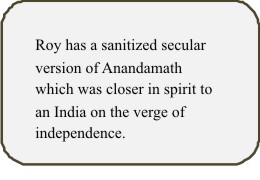Basanta Koomar Roy
Aurobindo's translation is true to the original and is unapologetic about it. There is not even an attempt to explain the militant Hindu sentiments expressed in the novel.  But Basanta Koomar Roy's translation is very different because he removes all the derogatory references references to Muslims that Bankim had in the source text. He also states that his translation is an 'adaptation' from the original Bengali. He wrote an introduction in which he went to great lengths to describe the revolutionary influence of Bankim, Anandamath and Aurobindo. But he did not explain the changes he had made to the text. His translation of the title was also interesting – Dawn over India . He was careful to avoid any religious connotation because ‘math' of Anandamath could be translated only as temple or as abbey as Nares Chandra Sengupta had done before him. Roy 's choice of title as Dawn over India is in keeping with the secular discourse of the nation that was being propagated in the 1940s. He has also completely done away with the final chapter of Bankim's text where a Healer enlightens Satyananda about his mission, which was to destroy Muslim rule in Bengal . He exhorts Satyananda to let the British rule India for as he explains: “Unless the English rule, it will not be possible for the Eternal Code ( sanatana dharma ) to be reinstated” (229, Lipner). The novel ends with Satyananda following the Healer or the Great One to the Himalayas, satisfied in the knowledge that he has accomplished his mission of ousting Muslims from Bengal . Roy avoids this as this would not have suited the nationalistic ideals of India in the 1940s when the anti-British sentiment was peaking. Besides, it would also have been detrimental to the carefully formulated secularist discourse of the future nation. Dr. William L. Jackson in his Preface explains: “The following translation of Anandamath by Basanta Koomar Roy was first published in 1941, during a critical period in India 's history when the independence movement had to take a decisive stance rejecting foreign rule. Hence, the mysterious physician's suggestion was deleted.” He goes on to state rather hestitantly: “We can only conjecture that if Chatterji had been alive he would have approved of this omission” ( Roy 7). But Basanta Koomar Roy's translation is very different because he removes all the derogatory references references to Muslims that Bankim had in the source text. He also states that his translation is an 'adaptation' from the original Bengali. He wrote an introduction in which he went to great lengths to describe the revolutionary influence of Bankim, Anandamath and Aurobindo. But he did not explain the changes he had made to the text. His translation of the title was also interesting – Dawn over India . He was careful to avoid any religious connotation because ‘math' of Anandamath could be translated only as temple or as abbey as Nares Chandra Sengupta had done before him. Roy 's choice of title as Dawn over India is in keeping with the secular discourse of the nation that was being propagated in the 1940s. He has also completely done away with the final chapter of Bankim's text where a Healer enlightens Satyananda about his mission, which was to destroy Muslim rule in Bengal . He exhorts Satyananda to let the British rule India for as he explains: “Unless the English rule, it will not be possible for the Eternal Code ( sanatana dharma ) to be reinstated” (229, Lipner). The novel ends with Satyananda following the Healer or the Great One to the Himalayas, satisfied in the knowledge that he has accomplished his mission of ousting Muslims from Bengal . Roy avoids this as this would not have suited the nationalistic ideals of India in the 1940s when the anti-British sentiment was peaking. Besides, it would also have been detrimental to the carefully formulated secularist discourse of the future nation. Dr. William L. Jackson in his Preface explains: “The following translation of Anandamath by Basanta Koomar Roy was first published in 1941, during a critical period in India 's history when the independence movement had to take a decisive stance rejecting foreign rule. Hence, the mysterious physician's suggestion was deleted.” He goes on to state rather hestitantly: “We can only conjecture that if Chatterji had been alive he would have approved of this omission” ( Roy 7).
Roy has also successfully decontextualised the story by completely suppressing its time frame. While Aurobindo and Lipner begin with the year in which the narrative unfolds (“It was a summer day in the Bengali year 1176”- Aurobindo; and “It is summer one day in 1770 in the village of Padachinha” – Lipner), Roy 's translation begins with “It was hot at Padachinha even for a summer day” (24). By taking away all references to the year 1770, Roy has removed all associations that can be made with the Sanyasi Rebellion of 1770 on which Bankim's narrative is based, thus giving his translation a secular flavour. Both Aurobindo and Lipner have retained Bankim's reference to Muhammad Reza Khan, the king's revenue officer who is callous to the plight of the starving people of Bengal, while Roy has blotted this out. While these translations speak about low caste people and forest dwelling people eating dogs, cats and mice out of desperation Roy says: “People of certain castes began to eat cats, dogs and rats” (24). |